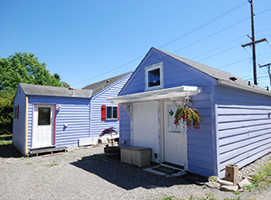There’s a nationwide conversation brewing around something called accessory apartments. In the past few years, communities have examined these use by right additions to single-family residences, and are praising them for their contribution to affordable housing.
Right here in Asheville, that conversation took place as early as 1948. “Garage” apartments are featured in the City’s first zoning ordinance adopted that year and have remained an option to this day. The current Unified Development Ordinance passed by Asheville City Council in 1997 also includes these provisions which dovetail nicely with the city’s current conversation about affordable housing.
“This is a long-standing feature here,” says Interim Planning Director Alan Glines, who adds that other city planners have approached Asheville for data on these dwellings. “We’ve been kind of a model city in this regard.”
Accessory apartments, sometimes called accessory dwelling units, are additions to single-family homes that function as a separate living space and that are permitted in areas zoned residential. Colloquially referred to as “Granny flats” or “Mother in Law Suites,” they can take the form of a garage apartment, a basement rental or even a separate structure. Under the city’s UDO, these dwellings can be no more than 500 square feet, or 25 percent of the size of the residential home.
That size arrangement has the benefit of keeping these apartments in the affordable range, and adds rental units to the city’s housing stock. They are ideal for college students, new Asheville arrivals or anyone in need of a smaller, lower-cost dwelling. At that size, they also have the added attraction of having a smaller footprint, a feature popular in the burgeoning “tiny house” movement.
“This is an important addition to our neighborhoods. It has provided the kind of flexibility that has served the city’s residents well.” Glines says “It has turned out to be an effective affordable housing tool in Asheville.”
The biggest benefit locally may come as the U.S. population ages. Organizations like the AARP point out that accessory apartments provide opportunities for elderly homeowners to bring in extra income, making it easier for them to stay in their homes. With Asheville’s elderly population projected to rise in the coming years, (according to this 2014 Housing Needs Assessment Report), this resource can prove valuable in helping them maintain an independent and quality lifestyle.
Likewise, for new homeowners, having a renter in an accessory apartment can help make mortgage payments more manageable, so more people can break into homeownership in Asheville.
The city’s Affordable Housing Advisory Committee has had its eye on accessory dwellings for some time, and chair Lindsey Simerly says it plans to keep focusing attention on the ways these design features can benefit Asheville.
“Accessory apartments are a win/win for both homeowners and renters in Asheville,” Simerly says. “Currently our city has an almost 0% vacancy rate, and these apartments can add much needed units for renters. Homeowners benefit from reliable monthly income, making their home more affordable and freeing up income for their own upward mobility.”
